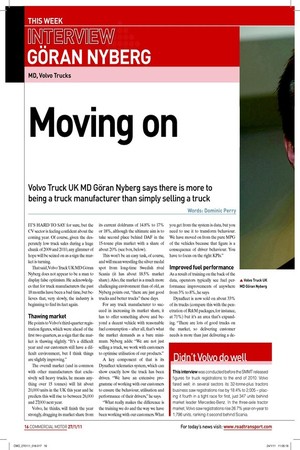Moving on
Page 14

Page 15

If you've noticed an error in this article please click here to report it so we can fix it.
Volvo Truck UK MD Göran Nyberg says there is more to being a truck manufacturer than simply selling a truck
IT’S HARD TO SAY for sure, but the CV sector is feeling conident about the coming year. Of course, given the desperately low truck sales during a huge chunk of 2009 and 2010, any glimmer of hope will be seized on as a sign the market is turning.
That said, Volvo Truck UK MD Göran Nyberg does not appear to be a man to display false optimism. He acknowledges that for truck manufacturers the past 18 months have been a bad time, but believes that, very slowly, the industry is beginning to ind its feet again.
Thawing market
He points to Volvo’s third-quarter registration igures, which were ahead of the irst two quarters, as a sign that the market is thawing slightly. “It’s a dificult year and our customers still have a dificult environment, but I think things are slightly improving.” The overall market (and in common with other manufacturers that exclusively sell heavy trucks, he means anything over 15 tonnes) will hit about 20,000 units in the UK this year and he predicts this will rise to between 26,000 and 27,000 next year.
Volvo, he thinks, will inish the year strongly, dragging its market share from its current doldrums of 14.8% to 17% or 18%, although the ultimate aim is to take second place behind DAF in the 15-tonne plus market with a share of about 20% (see box, below).
This won’t be an easy task, of course, and will mean wrestling the silver medal spot from long-time Swedish rival Scania (it has about 18.5% market share). Also, the market is a much more challenging environment than of old, as Nyberg points out, “there are just good trucks and better trucks” these days.
For any truck manufacturer to succeed in increasing its market share, it has to offer something above and beyond a decent vehicle with reasonable fuel consumption – after all, that’s what the market demands as a bare minimum. Nyberg adds: “We are not just selling a truck, we work with customers to optimise utilisation of our products.” A key component of that is its Dynaleet telematics system, which can show exactly how the truck has been driven. “We have an extensive programme of working with our customers to ensure the behaviour, utilisation and performance of their drivers,” he says.
“What really makes the difference is the training we do and the way we have been working with our customers. What you get from the system is data, but you need to use it to transform behaviour. We have moved on from the pure MPG of the vehicles because that igure is a consequence of driver behaviour. You have to focus on the right KPIs.”
Improved fuel performance
As a result of training on the back of the data, operators typically see fuel performance improvements of anywhere from 3% to 8%, he says.
Dynaleet is now sold on about 33% of its trucks (compare this with the penetration of R&M packages, for instance, at 71%) but it’s an area that’s expanding. “There are lots of good trucks on the market, so delivering customer needs is more than just delivering a de cent vehicle. When you buy a Volvo it comes with a commitment from us to make sure you get the best out of it. Our total offer is built on the premise that we become more a partner than a supplier,” he adds.
This commitment extends to maximising uptime, which Nyberg describes as “the best uptime in the market at present”. It also has one of the highest levels of customer satisfaction in Volvo’s European network, he points out.
Mind you, for all his praise of Volvo’s non-truck activities, without a decent product range to hang it on, it’s meaningless. Or, in other words, you can offer all the aftersales in the world, but it’s futile if you can’t get customers to buy the trucks in the irst place.
However, Nyberg contends that Volvo’s range – including the newly launched FMX tipper – is its “strongest ever”. The FH 6x2 tractor with a 13-litre engine and its I-Shift auto box is its top seller (Nyberg describes the I-Shift as virtually a standard-it item, with manual seen as an option). He believes certain factors – driver acceptance, fuel performance and residual values – combine to make it a strong proposition for the haulage sector.
“It ticks most of the boxes that a longdistance haulier wants,” he notes. Its second most-popular vehicle is the FM13 6x2 tractor, with I-Shift, and the Globetrotter XL cab, which is popular in the leet market (Sainsbury’s, Morrisons and Asda all have FMs in their leets).
So it’s not for nothing that Nyberg is optimistic for this year. “Even if this year shows progress, it will not be back to the normal level, but it’s a good step forward,” he notes. ■














































